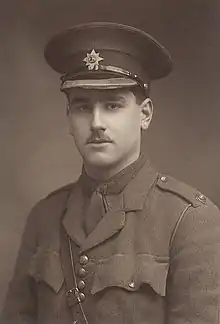John Kipling
John Kipling (17 August 1897 – 27 September 1915) was the only son of British author Rudyard Kipling. In the First World War his father used his influence to get him an army commission, despite his having been decisively rejected for poor eyesight. His death at the Battle of Loos caused his family immense grief, and placed a great strain on the marriage as Kipling's wife had strongly opposed his enlisting.
John Kipling | |
|---|---|
 John Kipling in the uniform of the Irish Guards, 1915 | |
| Born | 17 August 1897 Rottingdean, Sussex, England |
| Died | 27 September 1915 (aged 18) Loos-en-Gohelle, France |
| Buried | St Mary's ADS Cemetery, Haisnes |
| Allegiance | |
| Service/ | |
| Years of service | 1914–1915 |
| Rank | Second Lieutenant |
| Unit | Irish Guards |
| Battles/wars | First World War |
| Relations | Rudyard Kipling, father. Caroline Starr Balestier, mother. Josephine Kipling, sister. Elsie Bambridge, sister. |

Early life
Born in 1897, Kipling was the youngest of three children of the author Rudyard Kipling and his American wife Caroline Starr Balestier. He was born at "The Elms" at Rottingdean in Sussex, which was the Kiplings' home between 1897 and 1902. He was educated at Wellington College, Berkshire.
First World War
Kipling was 16 when the First World War broke out in August 1914. His father, a keen imperialist and patriot, was soon writing propaganda on behalf of the British government.[1] Rudyard sought to get his son a commission, but John was rejected by the Royal Navy due to severe short-sightedness. He was also initially rejected by the army for the same reason.[2]
However, Rudyard Kipling was friends with Frederick Roberts, 1st Earl Roberts, a former Commander-in-Chief of the British Army, and Colonel of the Irish Guards, and through this influence, John Kipling was commissioned as a second lieutenant into the 2nd Battalion, Irish Guards on 15 August 1914, at not quite 17.[3] After reports of the Rape of Belgium and the sinking of the RMS Lusitania in 1915, Rudyard Kipling came to see the war as a crusade for civilisation against barbarism,[4] and was even more keen that his son should see active service.
After completing his training John Kipling was sent to France in August along with the rest of the battalion, which was part of the 2nd Guards Brigade of the Guards Division.[5][6] His father was already there on a visit, serving as a war correspondent.[7]
Death
Kipling was reported injured and missing in action in September 1915 during the Battle of Loos. There remains no definite evidence relating to the cause of his death but credible reporting indicates he was last seen attacking a German position, possibly with a head injury. With fighting continuing, his body was not identified.
His parents searched vainly for him in field hospitals and interviewed comrades to try to identify what had happened. A notice was published in The Times on 7 October 1915 confirming the known facts that he was "wounded and missing".
The death of John inspired Rudyard Kipling to become involved with the Commonwealth War Graves Commission and write a wartime history of the Irish Guards. However, contrary to popular belief, the poem My Boy Jack does not allude to the wartime loss of his son, rather it was written about the death of Jack Cornwell, the youngest sailor killed at the Battle of Jutland. He also wrote the short verse: "'My son died laughing at some jest, I would I knew / What it were, and it might serve me at a time when jests are few."
Grave
The grave of Kipling was identified by Military Historian, Norm Christie, then Records Officer of the Commonwealth War Graves Commission in 1992, and now he is officially listed as buried in St Mary's ADS Cemetery in Haisnes.[8] In 2002 research by military historians Tonie and Valmai Holt suggested that this grave was that of another officer, Arthur Jacob of the London Irish Rifles.[9][10] In January 2016, however, further research by Graham Parker and Joanna Legg demonstrated that the original identification of the grave was correct. A spokesman for the Commonwealth War Graves Commission stated that it "welcomed the latest research which supports the identification of the grave of John Kipling".[11]
My Boy Jack
The play My Boy Jack was written in 1997 by David Haig. In 2007, it was adapted into a film of the same name, with Daniel Radcliffe as John Kipling.
References
- Bilsing, Tracey (Summer 2000). "The Process of Manufacture of Rudyard Kipling's Private Propaganda" (PDF). War Literature and the Arts. Archived from the original (PDF) on 12 November 2006. Retrieved 15 August 2013.
- "No. 29070". The London Gazette. 16 February 1915. p. 1565.
- Gilmour, David The Long Recessional: The Imperial Life of Rudyard Kipling, London: Farrar, Straus and Giroux, 2002 page 250.
- "No. 29363". The London Gazette (Supplement). 9 November 1915. p. 11161.
- The Long, Long Trail |http://www.longlongtrail.co.uk/army/regiments-and-corps/the-british-infantry-regiments-of-1914-1918/irish-guards/
- Lawrence, W (6 June 2011). "Rudyard Kipling – author, poet and quintessential Englishman". GWL Magazine. Archived from the original on 10 May 2014. Retrieved 10 May 2014.
- "Kipling, John". CWGC. Retrieved 20 January 2016.
- "'Wrong man' in Kipling son's grave". The Guardian. London. 4 November 2007. Retrieved 20 January 2016.
- Harrison, David (20 January 2002). "Kipling memorial 'on wrong grave'". The Daily Telegraph. London. Retrieved 20 January 2016.
- Furness, Hannah (19 January 2016). "Laid to rest, the mystery of a dear son's grave that haunted Kipling". The Daily Telegraph (11).